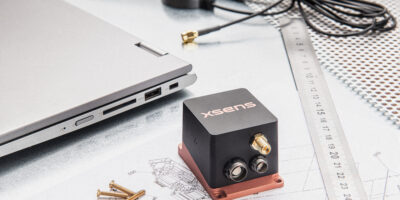Two products have been added by Xsens to MTi 600-series. They extend the portfolio of industrial tracking modules with and without an integrated satellite positioning receiver.
The first module to be added is the MTi-670G. This is a GNSS/inertial navigation system (INS) module. The second is a rugged attitude and heading reference system (AHRS), the MTi-630R. Both additions are suitable for use in harsh environments in maritime, mining and agricultural applications, says Xsens.
The MTi-670G and MTi630R are housed in an IP68-rated aluminium enclosure which measures 40.9 x 56.5 x 36.8mm. This design is “highly vibration- and shock-proof”, says Xsens. Both modules also feature standard controlled area network (CAN) and RS232 interfaces and an output data rate of up to 400Hz.
The MTi-670G GNSS/INS module includes a u-blox ZED F9 GNSS receiver. Sensor fusion firmware combines the receiver’s inputs with integrated 3D attitude (tilt, inclination) and heading measurements to provide absolute positioning accuracy of better than ±1m. The sensor has support for Xbus and standard NMEA and CAN protocols, for ease of integration into designs. There is also the provision of Xsens’ MT Software suite for developers. This includes the MT Manager graphical user interface (GUI) for Windows or Linux operating systems and a magnetic field mapper function.
The MTi-630R AHRS is a ruggedised version of Xsens’ MTi-630 AHRS. It offers roll/pitch measurement accuracy of ±0.2 degrees, and heading accuracy of ±1 degree. It is also supported with the MT Software suite, which also includes drivers for the LabVIEW, ROS and GO development languages.
The MTi-670G and MTi-630R are available for sampling now. Ruggedised versions of the MTi-610 inertial measurement unit (IMU) and MTi-620 vertical reference unit (VRU), the MTi-610R and MTi-620R, are available on request.
Xsens provides 3D motion sensing technology and products. Its sensor fusion technologies enable a seamless interaction between the physical and the digital world in applications such as industrial control and stabilisation, health, sports and 3D character animation. Clients and partners include Electronic Arts, NBC Universal, Daimler, Autodesk, ABB, Siemens and other leading institutes and companies around the world.
Xsens has offices in the Netherlands (Enschede), the USA (Los Angeles), China (Shanghai and Hong Kong) and India (Bangalore).
https://www.xsens.com.







